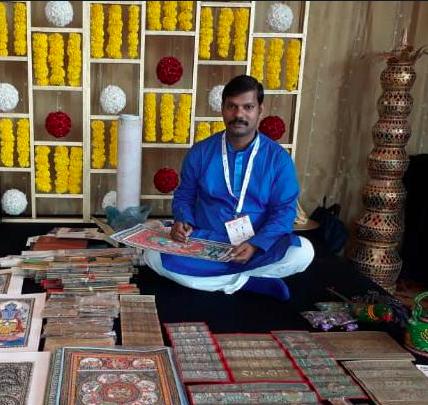Talapatra
Talapatra painting, an ancient art form originating from Odisha, India, is a testament to the rich cultural heritage and intricate artistry of the region. This art form involves creating exquisite illustrations on palm leaves (Talapatra), a medium that not only adds an organic texture to the artwork but also preserves the narratives of mythology, folklore, and nature for generations. Talapatra paintings are renowned for their meticulous detailing, vibrant color palettes, and intricate patterns, making them a unique and cherished part of India’s artistic tradition. The composition is typically symmetrical, with a strong emphasis on patterns and motifs that fill the entire surface, leaving little to no empty space.
Talapatra paintings predominantly feature themes rooted in Hindu mythology, including depictions of gods and goddesses, episodes from the Mahabharata and Ramayana, and the divine Leelas of Krishna. The art form also explores the harmony of nature, showcasing animals, birds, and floral motifs that reflect the interconnectedness of life.
History
Originally, Talapatra paintings were primarily used to illustrate sacred texts, astrological charts, and manuscripts. Artists would etch intricate designs onto the palm leaves, which were then stitched together to form manuscripts. Over time, the art evolved to include standalone works depicting Hindu deities, epic narratives, and scenes from daily life, expanding its appeal beyond religious confines.
Material and Method
Talapatra paintings are created on dried palm leaves, which are carefully selected, treated, and cut into desired sizes. The leaves are boiled and dried to remove moisture and then joined together with threads or adhesives to create a canvas. The artist begins by sketching the outlines using an iron stylus, which etches the design onto the leaf without the use of ink. The etched lines are then filled with natural dyes, often made from charcoal, turmeric, and other organic substances, to highlight specific areas. This process requires immense patience and skill, as the medium is unforgiving; once a line is etched, it cannot be erased or altered.
Significance
Talapatra painting holds immense cultural and historical significance as a symbol of Odisha’s artistic heritage. Beyond their aesthetic appeal, these artworks serve as a medium of storytelling, preserving the rich mythological and spiritual narratives of Indian culture. They are a bridge between the past and present, offering insight into the traditional values, beliefs, and artistic practices of ancient India. Talapatra paintings also play a crucial role in sustaining the livelihoods of many artisans in Odisha, contributing to the preservation and promotion of traditional crafts in a rapidly modernizing world. Their enduring appeal lies in their ability to blend art with spirituality, making them treasured pieces of cultural legacy.
FAQs
Are the colors used in Talapatra paintings eco-friendly?
Yes, the colors used in Talapatra paintings are typically derived from natural sources like charcoal, turmeric, and other organic substances. This eco-friendly approach not only preserves the traditional techniques but also ensures the sustainability of the craft.
What makes Talapatra painting unique?
Talapatra painting is unique due to its use of palm leaves as a canvas and the intricate etching technique that requires no ink or paint for the initial design. The artwork is celebrated for its detailed patterns, symmetry, and the spiritual narratives it conveys.
Can I customize a Talapatra painting?
MeMeraki offers customization options for Talapatra paintings, allowing customers to choose specific themes, sizes, or even personalized designs. Please contact our support team for more information on customization services.
![]() Get Upto 10% OFF on purchase of this product.
Get Upto 10% OFF on purchase of this product.
![]() Get upto 10% OFF on Live Workshops when sign up for 2 or more workshops.
Get upto 10% OFF on Live Workshops when sign up for 2 or more workshops.
![]() Get 10% OFF coupon code for Art Kits signing up for Masterclass or Live Workshop.
Get 10% OFF coupon code for Art Kits signing up for Masterclass or Live Workshop.
![]() Earn upto 1,749 Points on purchase of this product.
Earn upto 1,749 Points on purchase of this product.




